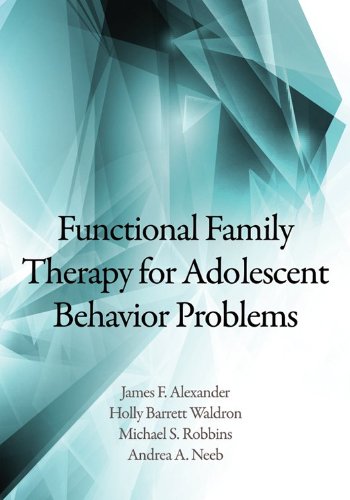3 inTrOduCTiOn adolescents with behavior problems go by various labels, such as difficult- to-treat adolescents, juvenile delinquents, at-risk youth, violent youth, and youth- ful offenders. They may have disruptive behavior disorder or substance abuse disorder, and they may be involved with the criminal justice system. These youth have problematic behaviors, emotions, and ways of thinking that often affect not only their families, but also their community. These youth, their families, and their successful treatment represent the focus of this book. Whatever labels are used to describe them, these adolescents represent one of the most difficult and recalcitrant treatment populations. although family members are often dissatisfied with the youth’s behavior and intensely focused on the need for him or her to change, the youth rarely self-refers and often seems undisturbed by his or her own behaviors. The impetus for treat- ment often stems from problems that are identified in the youth’s immediate social spheres (e.g., family or school) or formal social systems (e.g., juvenile dOi: 10.1037/14139-001 Functional Family Therapy for Adolescent Behavior Problems, by James f. alexander, Holly Barrett Waldron, Michael S. robbins, and andrea a. neeb Copyright © 2013 by the american Psychological association. all rights reserved. 4 functional family therapy for adolescent behavior problems justice, child welfare). irrespective of referral source, youth typically are unmotivated for treatment. at the same time, parents and other family members seem heavily invested in viewing problems in the family as resulting from the adolescent’s bad behavior. Their ideas of change revolve around a “problem individual” focus (the adolescent needs to change) and often have a punitive cast (“What he needs is for someone to smack him over the head and pound some sense into him!”). Therefore, some family members also are unmotivated or unwilling to be involved in the youth’s treatment. even when therapists can succeed in getting parents and youth into sessions, additional challenges are invariably encountered. family interac- tions are laced with hostility, anger, hopelessness, and frustration, all of which create a context that runs counter to or precludes adaptive change. it is not surprising that in many contexts, as many as 50% of youth referred for treat- ment fail to either show up for a first session or come back for a second session (Kazdin, Mazurick, & Siegel, 1994). further complicating the matter is that parents and parental figures themselves often face considerable challenges, such as poverty, depression, various forms of posttraumatic stress disorder, their own residue of previous challenges, substance use, and relational prob- lems (e.g., marital conflict, boyfriends if the mother is single, grandparents with whom the parents must still live)
چکیده فارسی
3 مقدمه نوجوانان مبتلا به مشکلات رفتاری با برچسب های مختلفی مانند نوجوانان دشوار درمان، بزهکاران نوجوان، جوانان در معرض خطر، جوانان خشن، و مجرمان جوان شناخته می شوند. آنها ممکن است اختلال رفتار مخرب یا اختلال سوء مصرف مواد داشته باشند و ممکن است با سیستم عدالت کیفری درگیر باشند. این جوانان دارای رفتارها، عواطف و طرز تفکر مشکل آفرینی هستند که اغلب نه تنها خانواده، بلکه جامعه آنها را نیز تحت تأثیر قرار می دهد. این جوانان، خانوادههایشان و درمان موفقیتآمیزشان محور این کتاب است. هر برچسبی که برای توصیف آنها استفاده می شود، این نوجوانان یکی از دشوارترین و سرکش ترین جمعیت های درمان را نشان می دهند. اگرچه اعضای خانواده اغلب از رفتار جوان ناراضی هستند و به شدت بر نیاز او به تغییر تمرکز می کنند، این جوان به ندرت به خود اشاره می کند و اغلب به نظر می رسد که از رفتارهای خود آشفته نیست. انگیزه برای درمان اغلب از مشکلاتی ناشی میشود که در حوزههای اجتماعی فوری جوانان (مانند خانواده یا مدرسه) یا سیستمهای اجتماعی رسمی (مانند نوجوانان dOi: 10.1037/14139-001 خانوادهدرمانی عملکردی برای نوجوانان، با مشکل رفتاری نوجوانان شناسایی میشوند. جیمز اف. الکساندر، هالی بارت والدرون، مایکل اس. رابینز، و آندریا آ نیب حق چاپ © 2013 توسط انجمن روانشناسی آمریکا. کلیه حقوق محفوظ است. 4 خانواده درمانی عملکردی برای مشکلات رفتاری نوجوانان عدالت، رفاه کودک). صرف نظر از منبع ارجاع، جوانان معمولاً انگیزه ای برای درمان ندارند. در عین حال، به نظر میرسد والدین و سایر اعضای خانواده به شدت در این امر سرمایهگذاری میکنند که مشکلات موجود در خانواده را ناشی از رفتار بد نوجوان بدانند. ایدههای آنها درباره تغییر حول محور تمرکز «فرد مشکلدار» میچرخد (نوجوان باید تغییر کند) و اغلب یک بازیگر تنبیهی دارند («آنچه او نیاز دارد این است که کسی به او ضربه بزند و کمی به او بکوبد!»). بنابراین، برخی از اعضای خانواده نیز بی انگیزه یا تمایلی به مشارکت در درمان جوانان ندارند. حتی زمانی که درمانگران می توانند در جذب والدین و جوانان در جلسات موفق باشند، همواره با چالش های اضافی مواجه می شوند. تعاملات خانوادگی با خصومت، خشم، ناامیدی و سرخوردگی همراه است، که همگی زمینهای را ایجاد میکنند که در تضاد با تغییرات انطباقی است یا از آن جلوگیری میکند. تعجب آور نیست که در بسیاری از زمینه ها، 50 درصد از جوانانی که برای درمان مراجعه می کنند، یا در جلسه اول حاضر نمی شوند یا برای جلسه دوم بازمی گردند (Kazdin, Mazurick, & Siegel, 1994). پیچیدهتر این موضوع این است که والدین و شخصیتهای والدین خود اغلب با چالشهای قابلتوجهی مانند فقر، افسردگی، اشکال مختلف اختلال استرس پس از سانحه، باقیمانده چالشهای قبلی، مصرف مواد، و مشکلات رابطهای (مانند تعارض زناشویی، دوست پسر اگر مادر مجرد باشد، پدربزرگ و مادربزرگ که هنوز والدین باید با آنها زندگی کنند)
ادامه ...
بستن ...
Author(s): James F. Alexander, Holly Barrett Waldron, Michael S. Robbins, and Andrea A. Neeb
Publisher: American Psychological Association (APA), Year: 2013
ISBN: 1433812940,9781433812941
ادامه ...
بستن ...










